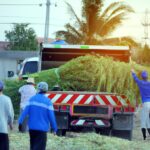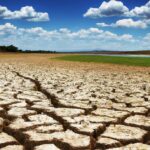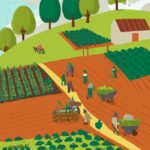Causes of food insecurity stem from a complex interplay of factors, often multifaceted in nature. Firstly, poverty plays a significant role, as individuals and families with limited resources struggle to afford nutritious food and meet their dietary needs. Additionally, economic instability, including unemployment and low wages, exacerbate food insecurity by restricting access to adequate food supplies. Natural disasters, such as droughts, floods, and hurricanes, also contribute by destroying crops and disrupting food production systems. Furthermore, conflicts and political instability can lead to the displacement of people and hinder the availability and distribution of food. Lastly, limited access to education, healthcare, and social services further perpetuate the cycle of food insecurity. Combined, these causes create a challenging environment where food access and availability become increasingly uncertain.
Food insecurity is primarily caused by various factors that hinder individuals and communities from accessing adequate and nutritious food. These causes can be grouped into three main categories: economic, environmental, and social.
Economic factors play a significant role in food insecurity. Poverty is a major contributor, as it limits people’s ability to buy food. High levels of inequality also exacerbate the problem, as a significant portion of the population cannot afford nutritious food items due to limited financial resources. Unemployment and low wages further restrict access to sufficient food, leaving individuals and families vulnerable to food insecurity.
Environmental factors also impact food availability and access. Climate change and extreme weather events such as droughts, floods, and storms can disrupt agricultural production, leading to crop failures and loss of livelihoods for farming communities. Land degradation, deforestation, and the depletion of natural resources contribute to the degradation of ecosystems, reducing the productivity of land and water bodies for food production.
Social factors, including conflicts and political instability, also contribute to food insecurity. Instances of armed conflict, civil unrest, or political instability disrupt food systems, leading to the displacement of communities and hindering agricultural production and trade. Additionally, discrimination, gender inequality, and social marginalization can affect access to food, with certain groups experiencing higher rates of food insecurity than others.
Moreover, underlying all these causes is the lack of investment in agriculture, infrastructure, and social welfare systems. Insufficient support for small-scale farmers and inadequate access to credit, markets, and agricultural inputs impede food production and availability. Limited access to healthcare, education, and social safety nets further exacerbates the vulnerability of individuals and communities.
In summary, the complex causes of food insecurity involve economic, environmental, and social factors. Addressing these causes requires a comprehensive approach that encompasses poverty reduction, sustainable agricultural practices, environmental conservation, and social inclusion to ensure access to adequate and nutritious food for all.
Issues related to climate change
Climate change is an overarching global issue that has serious implications for food security. The impact of climate change on agricultural production and food systems is multifaceted and encompasses various interconnected factors. One of the key issues related to climate change and food insecurity is the increasing frequency and intensity of extreme weather events.
Extreme weather events, such as droughts, floods, and storms, can significantly affect crop production. Droughts, for example, reduce water availability, leading to decreased yields and crop failure. Floods, on the other hand, can destroy crops, contaminate fields with sediment and pollutants, and cause soil erosion, rendering the land unsuitable for farming. These extreme weather events not only affect the current food production but also have long-term consequences, as they can disrupt planting and harvesting seasons, hinder irrigation systems, and damage infrastructure necessary for food production and distribution.
Rising temperatures and changing rainfall patterns are other consequences of climate change that impact food security. With increasing temperatures, certain crops may face reduced yields or quality. For instance, heat stress can negatively affect grain filling in cereals, ultimately resulting in lower yields. Changes in rainfall patterns can also have detrimental effects on agriculture. In regions with decreased rainfall, irrigation may be necessary to sustain crop production, adding significant strain to already scarce water resources. Conversely, increased rainfall can lead to soil erosion, nutrient leaching, and increased pest and disease outbreaks, all of which can significantly affect crop yields.
Furthermore, climate change can also destabilize ecosystems and disrupt natural food systems. It can lead to the loss of biodiversity and the disruption of ecological processes that are critical for pollination, pest control, and nutrient cycling. For example, changes in temperature and precipitation patterns can affect the lifecycle of pollinators, such as bees and butterflies, leading to reduced pollination and lower crop yields. These disruptions in natural food systems can have cascading effects on food production and food availability.
Lastly, climate change can exacerbate existing vulnerabilities and inequalities, particularly in developing countries. Small-scale farmers, who heavily rely on agriculture for their livelihoods and food security, are often disproportionately affected by climate change. Limited access to resources, such as land, water, and technological innovations, further exacerbate their vulnerability. These farmers may lack the means to adapt to changing climate conditions, making them more susceptible to food shortages and economic instability.
In conclusion, climate change poses significant challenges to food security. The increasing frequency and intensity of extreme weather events, changing rainfall patterns, rising temperatures, ecosystem disruptions, and socio-economic vulnerabilities all contribute to the overall issue. Addressing these challenges requires comprehensive strategies that focus on building resilience, promoting sustainable agricultural practices, ensuring equitable access to resources, and implementing climate change adaptation and mitigation measures.
poverty and inequality
Poverty and inequality are two significant factors contributing to the prevalence of food insecurity across the globe. The persistence of these issues exacerbates the challenges faced by individuals and communities in accessing adequate and nutritious food.
Poverty, often defined as a lack of income or insufficient resources to meet basic needs, is a primary driver of food insecurity. The absence of financial means prevents individuals from acquiring enough food to sustain themselves and their families adequately. Poverty is particularly problematic in developing countries, where a significant portion of the population struggles to meet their basic needs due to limited employment opportunities, low wages, and inadequate social support systems.
Inequality, on the other hand, refers to the unequal distribution of wealth and resources within a society. When resources are concentrated in the hands of a few, marginalized groups face disproportionate challenges in accessing adequate food. Inequality can arise from various factors such as gender discrimination, social and economic disparities, and unequal access to education and healthcare. These disparities perpetuate cycles of poverty and food insecurity, creating a vicious cycle that is challenging to break.
Moreover, inequality extends beyond just the distribution of resources. It also encompasses access to productive assets like land, credit, and technology. When marginalized communities lack access to these resources, their ability to produce enough food for themselves and generate income is severely hindered. This further traps them in a cycle of poverty and exacerbates their vulnerability to food insecurity.
The connection between poverty, inequality, and food insecurity is complex and multifaceted. Poverty reduces individuals’ purchasing power, limiting their ability to buy nutritious food. Inequality further hampers their access to resources and opportunities, perpetuating the cycle of poverty and limiting their capacity to overcome food insecurity. Additionally, individuals living in poverty often lack access to education and healthcare, which can further worsen their food security situation.
To address these challenges, comprehensive strategies that tackle both poverty and inequality are necessary. These can include measures such as increasing investments in social protection programs, improving access to quality education and healthcare, promoting sustainable agricultural practices, and empowering marginalized communities through avenues for income generation and entrepreneurship. By addressing poverty and reducing inequality, societies can take significant steps towards creating a more equitable and food-secure world.
In conclusion, poverty and inequality play crucial roles in perpetuating food insecurity. The lack of financial resources and the unequal distribution of wealth and resources limit individuals’ access to adequate and nutritious food. Tackling these complex issues requires comprehensive strategies that address the root causes of poverty and inequality, empowering marginalized communities and creating opportunities for sustainable development.
conflict and instability
Conflict and instability are major contributing factors to food insecurity around the world. When a country or region experiences conflict, it often disrupts the agricultural systems and exacerbates existing food shortages. Here are some key points on conflict and instability:
1. Disruption of agricultural activities: Conflict leads to the displacement of people, destruction of infrastructure, and disruption of agricultural activities. Farmers are forced to abandon their fields and livestock, making it difficult to produce food. This disruption can last for years, leading to long-term food insecurity.
2. Loss of livelihoods: Conflict often results in the displacement of communities and destruction of property. People lose their homes, jobs, and sources of income, making it challenging for them to access food. Many become dependent on external aid and struggle to meet their basic food needs.
3. Destruction of critical infrastructure: Conflict can lead to the destruction of vital infrastructure such as roads, bridges, markets, and storage facilities. This means that even if agricultural production continues, it becomes difficult to transport and store food. As a result, food spoilage occurs, and food availability becomes limited.
4. Limited access to markets: Conflict zones often experience restricted movement, checkpoints, and blockades, making it difficult to access nearby markets for both farmers and consumers. This lack of access to markets hampers trade and increases the cost of food, making it unaffordable for many.
5. Disruption of food distribution systems: Conflict disrupts supply chains and relief operations, making it challenging to distribute food to vulnerable populations. Humanitarian organizations face obstacles in delivering aid to conflict-affected areas, leading to further food shortages.
6. Insecurity affecting agricultural practices: In conflict-affected areas, farmers and agricultural workers may face threats and violence, hindering their ability to work in the fields. Fear and insecurity can prevent individuals from engaging in farming activities, leading to reduced production and food scarcity.
7. Emergence of food-related conflicts: In some instances, conflicts may arise due to competition over scarce resources, including food and water. As food insecurity worsens, tensions escalate, leading to further conflicts and instability.
Conflicts and instability not only directly impact food production and distribution but also perpetuate cycles of poverty and inequality, which contribute to long-term food insecurity. Addressing the root causes of conflict and investing in conflict prevention and resolution are vital steps towards promoting food security globally.
inadequate infrastructure and lack of access to resources and education.
Inadequate infrastructure and lack of access to resources and education contribute significantly to the problem of food insecurity in many regions around the world. These factors create barriers that prevent individuals and communities from effectively accessing and utilizing food resources, leading to increased vulnerability and limited food availability.
One of the main reasons for food insecurity related to inadequate infrastructure is the poor condition of transportation networks. In many rural areas or impoverished communities, roads, bridges, and other transportation infrastructure may be insufficient or in disrepair. This makes it difficult for farmers to transport their produce to markets, leading to limited opportunities for income generation and reduced access to nutritious food for the local population.
Additionally, inadequate storage facilities and post-harvest infrastructure add to the challenges faced by farmers. Without proper facilities to store and preserve their crops, farmers often face high rates of post-harvest losses due to spoilage and waste. This not only affects their livelihoods but also contributes to the overall scarcity of food in the area.
Lack of access to resources, such as land and agricultural inputs, further exacerbates food insecurity. In many developing countries, land ownership patterns are inequitable, with a few large landholders controlling the majority of arable land. This leaves small-scale farmers with limited access to land, reducing their ability to produce enough food for themselves and their communities. Additionally, the high cost and limited availability of fertilizers, seeds, and other agricultural inputs make it difficult for farmers to maximize their productivity and yields.
Education plays a crucial role in addressing food insecurity by empowering individuals with the knowledge and skills needed for sustainable agriculture and food production. However, access to quality education in many food-insecure regions is often limited. Lack of educational opportunities prevents individuals from learning modern farming techniques, efficient water management practices, and other important skills necessary for increasing agricultural productivity. As a result, farmers may struggle to grow enough food to meet their families’ needs and contribute to local food security.
Furthermore, education plays a vital role in nutritional awareness and understanding the importance of balanced diets. Without proper education, communities may lack the knowledge needed to address issues such as malnutrition and food safety, leading to continued food insecurity and related health problems.
Inadequate infrastructure and lack of access to resources and education are interconnected factors that significantly impact food security. To tackle food insecurity effectively, investments must be made in improving infrastructure, providing equal access to resources, and promoting education for sustainable agricultural practices. Only by addressing these underlying challenges can we hope to create a more equitable and food-secure future for all.













